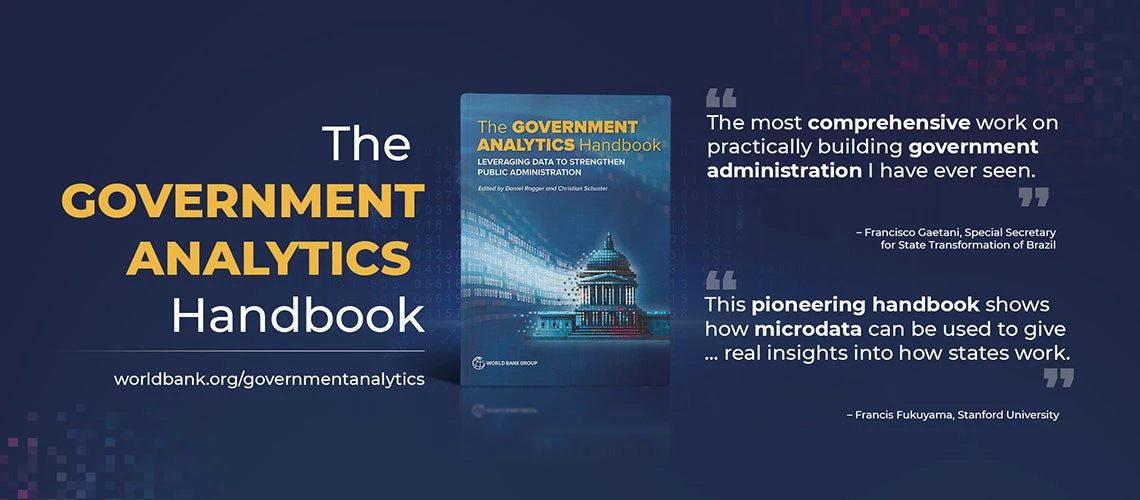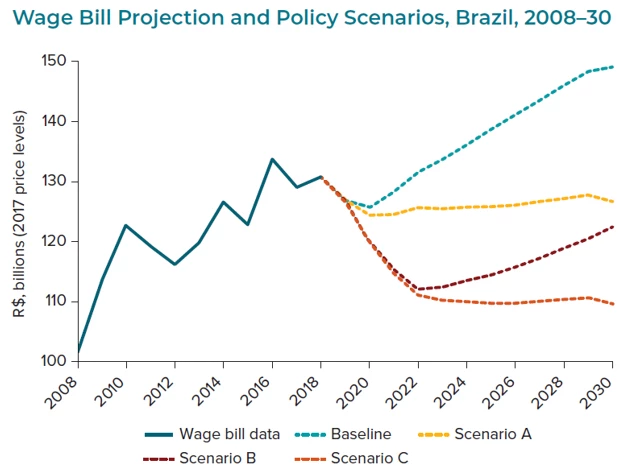 Quotes and the cover of "The Government Analytics Handbook". | © World Bank
Quotes and the cover of "The Government Analytics Handbook". | © World Bank
Recent research has showcased the power of government microdata for understanding the functioning of the state. As highlighted in various job market guest blogs on the Development Impact blog, Guo Xu et al.’s VoxDev literature review, and Dan’s own DEC Policy Research Talks (2019 | 2023), the research world is using this data to contribute profound insights into the intricacies of state operations.
This research is a foundation for discussions at the World Bank and amongst members of the public service across the world as to how to strengthen the state. A recurring theme in these discussions is the potential of governments to integrate “government analytics” more systematically into their operations to generate a far greater, and more targeted, set of such insights.
Take payroll data for example. Researchers have used payroll records to identify the impacts of politically motivated appointments to the public service, and the differential routes to successfully climbing the career ladder. However, the same data could be used by every government to assess whether the pay of public servants is fiscally sustainable. de Albuquerque Tavares, Nieto and Woodhouse (2023) discuss how pay conditions existing in 2015 in Brazil’s Federal Government would have meant a budget crisis. But simple modelling allowed them to provide other scenarios to government to plot a more sustainable course. Figure 1 below shows the scenarios their team presented to government. This inspired similar analysis in many of Brazil’s states, leading to more effective payroll management across the country, and ensuring government’s ability to keep investments flowing to delivering services.

Figure 1. Wage Bill Projections under different Policy Scenarios, 2008–30. Source: de Albuquerque Tavares, Nieto and Woodhouse (2023) ‘Government Analytics Using Human Resources and Payroll Data’ Chapter 10 of ‘The Government Analytics Handbook’
The vast opportunities to enhance government functioning through strategic use of administrative and survey data are undeniable. There's a growing consensus among researchers and governments alike on the benefits of establishing dedicated analytical units within governments to foster a culture of data-driven decision-making.
To support government’s own analytical work on these issues, we have developed The Government Analytics Handbook. The Handbook aims to draw together insights from a diverse range of experts including World Bank staff, academicians, and policy analysts. It aims to provide a roadmap for governments and the analytics community to leverage data for a more profound understanding of government processes.
The Handbook outlines a variety of data sources available to public sector managers, demonstrating how they can be used to gain a detailed picture of how government works—and where it could work better. It serves as a practical guide for public sector managers—and any officials interested in strengthening their public administration through government analytics. Accompanying the Handbook are toolkits available on worldbank.org/governmentanalytics to help readers implement the analytics discussed. These tools empower public officials to enhance productivity immediately and cost-effectively, utilizing existing data.
For government analysts, this Handbook addresses a spectrum of management challenges, ranging from cost-effective procurement and employee motivation to competitiveness in compensation and corruption in public expenditure. It enables pinpointing organizational strengths and weaknesses, facilitating informed decision-making that can lead to cost savings, improved motivation, and enhanced productivity. Researchers and analysts working outside government will find the Handbook a valuable reference, showcasing the capabilities of government analytics and providing scalable examples of analytical work. It also includes guidance on using the Handbook as a teaching tool.
The Government Analytics Handbook is structured to help readers quickly identify sources of data they already have access to, and it offers practical advice about repurposing these data for analytics, as well as examples of the many possible insights that can be generated:
- Part 1 of the Handbook offers a broad overview of government analytics. Read this if you are busy or want an introduction to the topic.
- Part 2 lays a foundation for government analytics by outlining cross-cutting themes, such as statistical tools and skills, holistic measurement approaches, and ethical principles that make government analytics effective.
- Part 3 dives into the many sources of administrative data available in government databases. It includes chapters on (among other data sources) human resources and payroll data, procurement data, case productivity data, and expenditure data, as well as the different questions they help answer about the wage bill, corruption, customs efficiency, cost-effective procurement, spending, and everything in between.
- Part 4 explains how to use data from public servant surveys to better understand how public sector organizations work and measure the quality of management. It also offers an overview of the latest research into how to design and implement these surveys as effectively as possible.
- Part 5 turns to external assessments—including household and citizen surveys, measures of service delivery, and anthropological studies—to show how these data sources offer a richer overall picture of government processes and outcomes.
Scaling up the analysis of government data is crucial for a deeper understanding of public administration. We eagerly anticipate your feedback, experiences, successes, and ideas that could shape the second volume of the Handbook.



Join the Conversation